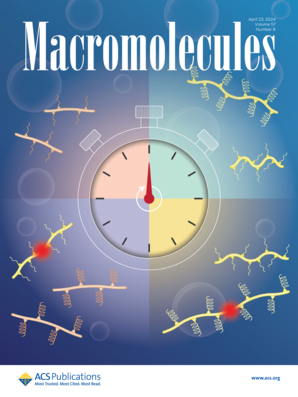三维聚合物的分子大小、多分散性和分支单位分布函数的概率方法:Flory在1941年工作的延续
IF 5.1
1区 化学
Q1 POLYMER SCIENCE
引用次数: 0
摘要
这项研究扩展了Flory在1941年关于三功能分支单元三维阶梯生长聚合(SGP)的基础工作。Flory在当时为理解聚合物粒度分布奠定了基础,但是他并没有对A2 + A3和A2 + A3 + B2类型体系中的多分散性和/或平均聚合度进行充分的探索。随着对先进三维高分子材料需求的增长,需要一个更全面的理论框架。在这项工作中,通过Flory的概率方法导出了三官能团支链聚合物的数平均度(Xn)、重量平均度(Xw)和多分散性(Đ)的新的解析表达式。此外,我们引入了分支单位分布(BUD)的概念,这是以前没有研究过的。通过实验结果和蒙特卡罗模拟的对比,验证了这一新的理论概念。我们的发现为三维支化聚合物的内部结构提供了新的见解,为未来设计和开发新型材料提供了有价值的指导。本文章由计算机程序翻译,如有差异,请以英文原文为准。
Probability Method of Molecular Size, Polydispersity, and Branch Unit Distribution Function for the Three-Dimensional Polymers: A Continuation of Flory’s Work in 1941
This study extends Flory’s 1941 foundational work on three-dimensional step-growth polymerization (SGP) with trifunctional branching units. Flory laid the groundwork for understanding polymer size distribution back then, however, he did not fully explore the polydispersity and/or average degree of polymerization in A2 + A3 and A2 + A3 + B2 types of systems. As the demand for advanced three-dimensional polymer materials grows, a more comprehensive theoretical framework is required. In this work, new analytical expressions are derived for the number-average (Xn), weight-average (Xw) degree of polymerization, and polydispersity (Đ) of trifunctional branched polymers through Flory’s probability method. Additionally, we introduce the concept of Branch Unit Distribution (BUD), which has not been previously investigated. This new theoretical concept is validated through comparison with both experimental results and Monte Carlo simulations. Our findings provide new insights into the internal structure of three-dimensional branched polymers, offering valuable guidance for future design and development of novel materials from SGPs.
求助全文
通过发布文献求助,成功后即可免费获取论文全文。
去求助
来源期刊

Macromolecules
工程技术-高分子科学
CiteScore
9.30
自引率
16.40%
发文量
942
审稿时长
2 months
期刊介绍:
Macromolecules publishes original, fundamental, and impactful research on all aspects of polymer science. Topics of interest include synthesis (e.g., controlled polymerizations, polymerization catalysis, post polymerization modification, new monomer structures and polymer architectures, and polymerization mechanisms/kinetics analysis); phase behavior, thermodynamics, dynamic, and ordering/disordering phenomena (e.g., self-assembly, gelation, crystallization, solution/melt/solid-state characteristics); structure and properties (e.g., mechanical and rheological properties, surface/interfacial characteristics, electronic and transport properties); new state of the art characterization (e.g., spectroscopy, scattering, microscopy, rheology), simulation (e.g., Monte Carlo, molecular dynamics, multi-scale/coarse-grained modeling), and theoretical methods. Renewable/sustainable polymers, polymer networks, responsive polymers, electro-, magneto- and opto-active macromolecules, inorganic polymers, charge-transporting polymers (ion-containing, semiconducting, and conducting), nanostructured polymers, and polymer composites are also of interest. Typical papers published in Macromolecules showcase important and innovative concepts, experimental methods/observations, and theoretical/computational approaches that demonstrate a fundamental advance in the understanding of polymers.
 求助内容:
求助内容: 应助结果提醒方式:
应助结果提醒方式:


